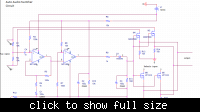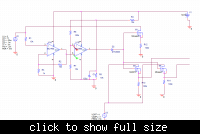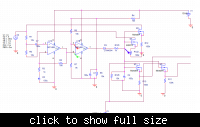bwinter88
Newbie level 6
I'm working on a circuit with one output which switches between two inputs. The application is for a car radio; normally, the FM signal goes through to the speaker amp, but when an iPod or attached accessory begins to play, I'd like the output to switch over to that input automatically.
The circuit is based off of a similar circuit used to activate a relay for power (**broken link removed**) instead of using MOS as switches. My understanding is to use a comparator between a small reference voltage and the auxiliary input. When the input goes above the reference voltage, the output is high and instead of a relay, is connected to the gates of two NMOS (L and R of aux input) and two PMOS (L and R of default input). So the NMOS pair turns "on" and the PMOS pair turns "off."
My question is two-fold: 1, can someone take a look at my circuit and see if my thinking is right? I don't like the idea of connecting the PMOS and NMOS outputs together with just a solder dot, can I do that? and 2, I haven't the foggiest idea of what exact model # of transistors to use. My best thought is to look at Digikey and see which transistors they carry the most--assuming that's an indicator of the most popular--but what I'm really looking for is someone to tell me there's a "bread and butter" N- and P-MOS transistor pair that is used for household audio electronics.
Thanks! See circuit below.

The circuit is based off of a similar circuit used to activate a relay for power (**broken link removed**) instead of using MOS as switches. My understanding is to use a comparator between a small reference voltage and the auxiliary input. When the input goes above the reference voltage, the output is high and instead of a relay, is connected to the gates of two NMOS (L and R of aux input) and two PMOS (L and R of default input). So the NMOS pair turns "on" and the PMOS pair turns "off."
My question is two-fold: 1, can someone take a look at my circuit and see if my thinking is right? I don't like the idea of connecting the PMOS and NMOS outputs together with just a solder dot, can I do that? and 2, I haven't the foggiest idea of what exact model # of transistors to use. My best thought is to look at Digikey and see which transistors they carry the most--assuming that's an indicator of the most popular--but what I'm really looking for is someone to tell me there's a "bread and butter" N- and P-MOS transistor pair that is used for household audio electronics.
Thanks! See circuit below.

Last edited:

